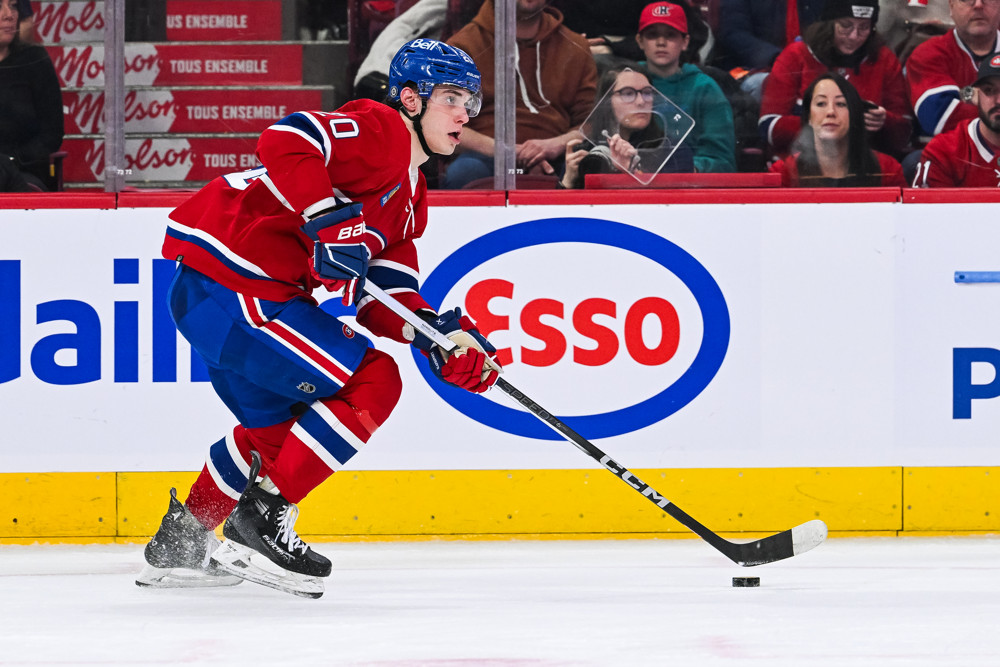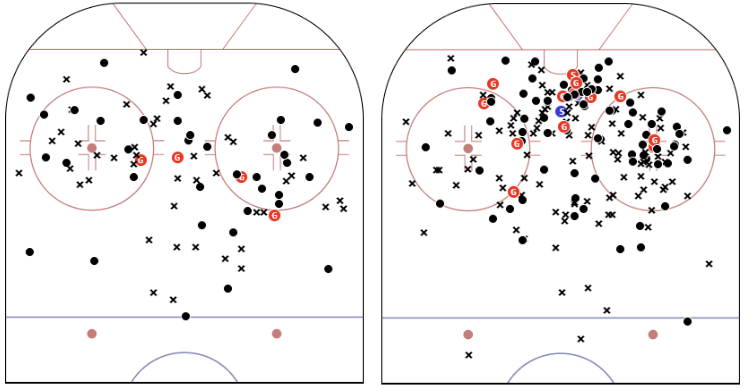
When the Montreal Canadiens called Juraj Slafkovsky’s name with the first overall selection of the 2022 NHL Draft, they immediately placed the weight of being the number one player taken in that draft class.
For the rest of Slafkovsky’s career, he will carry that burden and will always be held to a higher standard compared to every other player in the 2022 class. As well, he’ll be compared to other first-overall picks from other classes.
Since the day he was drafted, Slafkovsky and the Canadiens’ choice has been questioned. Why not Shane Wright, who was widely considered the class's top prospect? Or Logan Cooley, who was (and is) considered to be the most skilled player in the class, arguably? That carried into his rookie season, where Slafkovsky managed just 10 points (four goals, six assists) in 39 games, and into the start of the 2023-24 season as well. Did the Habs make the wrong choice?
This is going to be a discussion that doesn’t go away for years to come, especially as more 2022-drafted prospects break into the league and are measured against the yardstick that is Slafkovsky.
There’s no question that in Slafkovsky’s draft year, the hulking winger turned scout’s heads. He played the majority of the season in the Liiga with TPS and was a standout for the Men’s National team at both the World Championships and the Olympics. He won MVP of the Olympics, leading the event in points and helping Slovakia to a bronze medal. He led all U20 players in points at the World Championships and was named a top three player on the team. For his efforts, which also included a Hlinka Gretzky silver medal and a Liiga second-place finish, he was named the Slovakian Player of the Year.
Here’s an excerpt from the McKeen’s 2022 NHL Draft Guide from scout Chapin Landvogt on Slafkovsky’s game:
“A big, powerful skater who has already proven himself at the men’s level like no other player in this draft, Slafkovsky is not only believed to be one of the best overall players whatsoever in this draft but universally seen as ready to step right into an NHL line-up. Measuring 6-foot-4, 218 pounds, Slafkovsky has the size and physical demeanour most teams can only dream of. And he combines all this with some of the best skill and goal-scoring prowess this draft has to offer.”
Reading that, and taking a look at his draft year resume, is it really surprising that the Canadiens selected him? They had proof that the left winger could not only handle himself while playing under tremendous pressure but also excel and exceed expectations.
Wright didn’t have the year that was expected of him, with some consistency issues in regards to his competitiveness raising flags. This was not an issue for Slafkovsky. With Cooley, there were slight questions around his size at 5-foot-10 and whether or not he’d be able to bring a finishing touch to the NHL level or fall into more of a playmaker role (which may be a fair assessment still in his rookie season with the Arizona Coyotes). But, both of these were not flags with Slafkovsky.
So, Slafkovsky very much had an argument to be the first player off the board in 2022. The fact that he wasn’t the consensus number one has nothing to do with Slafkovsky as an individual player, but as a draft class as a whole. The 2022 group was a below-average draft class. It was lacking that sure-fire, franchise, or elite number-one prospect. It could even be argued that is was lacking two top tiers found in many (not all) classes.
Herein lies another problem for Slafkovky’s perfect storm of expectations: comparing first-overall picks. Not including 2023’s Connor Bedard just yet, the previous five forwards drafted first overall were Slafkovsky, Alexis Lafreniere (2020), Jack Hughes (2019), Nico Hischier (2017), and Auston Matthews (2016). All five stepped right into the NHL the year after being drafted.
The problem though, is that only Slafkovsky and Lafreniere are wingers. And then, Lafreniere’s rookie season was his 19-year-old season whereas Slafkovsky’s was his 18-year-old season. How can you compare Hughes to Slafkovsky? Lafreniere to Slafkovsky? They aren’t on a level playing field - despite all three earning criticism in their early days in the NHL.
However, if you do start to compare, it does get quite interesting. Through Lafreniere’s first 100 NHL games (a reasonable sample size), he had 33 points (21 goals, 12 assists) and 0.33 points per game. Slafkovksy, now at 96 NHL games, has 40 points (16 goals, 24 assists) and 0.42 points per game. Both players are now on the rise in the 2023-24 season, truly coming into their own. Let’s add in Hughes too - through his first 96 games? 37 points (14 goals, 23 assists) for 0.39 points per game. Huh.
Slafkovsky’s in an interesting situation. It’s very rare for an 18-year-old winger to break into the NHL. According to Michael Clifford from EP Rinkside, over the last 10 seasons, the list of wingers to do that includes Zach Benson this season, Andrei Svechnikov, David Pasternak (who started his season in the AHL), Kaapo Kakko, and Patrik Laine. That’s it. It’s typically centremen or defenders that make that early jump. Making it even more impressive, the quality of the NHL game has been improving over the years, making it even more difficult for young players to not only break into the league but succeed there.
This is shown in player age curves, such as this article from Evolving Wild explains on Hockey Graphs, and I would expect this to be a steeper rise now, seven years later. But even here, we can see a steep incline for forwards until players are approximately 21 (Slafkovsky is still just 19), and that still increases until approximately 26 years old. Slafkovsky is still on the upswing here and likely will be for the next two seasons before he even begins to enter his prime.
Did the Habs rush him? I’d say yes. I do believe that it would have benefitted him to spend a season in the AHL, succeed, and start in the NHL this season. I think that would have been huge for his confidence, for settling into the transition from Europe to North America, and would have allowed him to settle without major expectations in year one. As a first-overall pick though, there was pressure and expectations for him to be able to step right into the NHL. And now that he’s there, I do agree with the decision to not send him down, and that would only place more pressure on him to earn his promotion and could be quite damaging to his confidence.
Regardless, we are starting to see the player Slafkovsky will be. Remember, he’s just 19. Players are still getting drafted at 19 years old, never mind playing on the top line in one of the biggest markets of the NHL.
This season, and especially as of late, Slafkovsky’s been on a tear. He recently wrapped up an eight-game point streak, racking up 12 points (six goals, six assists). Slafkosky’s ability to be a leader on the Canadiens roster in the transition game has been huge, and a tremendous improvement from his rookie season. He’s playing more confidently, getting off the wall, leading entries, and taking charge of the offensive rush.
What stands out to me most though, is the strides made in his decision making. He’s picking his shots better, cutting in to get a shot off from the inside versus sticking to the perimeter. Even his passes, he’s timing them well to draw defenders in, to pull goaltenders out of position, and to give his teammates the best chance to finish. Just take a look at the comparison in shots from his rookie season and this season (2022-23 on the left, 2023-24 on the right):

On top of simply having a much bigger sample size, Slafkovsky’s picking his shots better. That concentration around the net front is a massive difference from last year, and the weight of shots coming from the inside is greater. Don’t be surprised to see this continue to improve and the Slovakian to start putting up impressive goal totals in the coming years.
Now, this is a bit of a text-heavy piece, but I do want to show the improvement that Slafkovsky’s taken thus far in his career with two clips that I would consider a broad attempt to summarize his two seasons. First, this video from his rookie year:
Slafkovsky gets the pass to enter the zone, but rather than attacking with speed or even dumping the puck, you can see the wheels turning as he tries to see if a pass is available. He’s reacting to the play around him rather than dictating play himself. As well, both when he receives the pass and in the offensive zone, watch his head. He’s staring down at the puck rather than scanning the ice, where he could notice that a rim around the boards would likely reach Nick Suzuki on the opposite side. This is a player who is not confident in his play. Jacob Trouba is easily able to knock the puck away and end the attack.
But now, watch this clip from this season:
This is almost the same play as the last clip. Slafkovsky gets the pass to gain the zone and again doesn’t attack with speed. But this time, his head is up and scanning the entire way in and even with the defender on him and closing in, holds the puck away and times his rim to Suzuki perfectly to not just gain the zone but maintain it. The comparison in these two clips shows that Slafkovsky is getting comfortable in the NHL and is building confidence. That’s something that the league should be nervous about.
Alright, I lied. There’s one more clip I want to show here, building off this growth in confidence as well as his timing:
Again, this is a very different player from that first clip. Slafkovsky plays the bumper on the power play for the Canadiens (which might be obvious if you look closely at his shot map this year). In this clip, he gets the pass along the wall (again, notice that his head is up the whole time scanning) and his job here is to a) manipulate the defenders and goaltender to get them out of position and b) distribute the puck. Slafkovksy turns, and patiently approaches the net and middle, making it seem like a shot is coming or a pass below the goal line. This pulls St. Louis Blues’ goaltender Jordan Binnington closer to his post and clears Blues #47’s stick out of the lane so that he can fire a perfect cross-slot pass to - once again - Suzuki for a goal.
To summarize, Slafkovsky is too early in his career to be judged. He has unrealistic expectations attached to him due to being the first overall pick, despite no player from the 2022 class likely being a first overall in another year’s draft class. He’s still a teenager years away from his prime and he’s playing a position that often takes longer to develop and reach the NHL. However, the strides forward are happening before our eyes and at an impressive rate. Stay patient and enjoy the climb - the best is yet to come.































